-
PDF
- Split View
-
Views
-
Cite
Cite
Miguel Chaput, Denis Bouchard, Philippe Demers, Louis P. Perrault, Raymond Cartier, Michel Carrier, Pierre Pagé, Michel Pellerin, Conversion to sinus rhythm does not improve long-term survival after valve surgery: insights from a 20-year follow-up study, European Journal of Cardio-Thoracic Surgery, Volume 28, Issue 2, August 2005, Pages 206–210, https://doi.org/10.1016/j.ejcts.2005.03.014
Close - Share Icon Share
Abstract
Objective: Atrial fibrillation (AF) is frequently associated with valvular heart disease and a common complication of valve surgery. Its contribution to long-term mortality and morbidity remains debated. Our objective was to determine the impact of AF on long-term mortality and embolic complications after valvular surgery and the benefit of conversion to sinus rhythm. This may provide insight to the clinical advantages of surgical anti-AF procedures. Methods: Data concerning rhythm status, mortality and embolic complications were prospectively collected for 5466 patients with valve surgery. Patients had surgery between 1979 and 2003. Follow-up was complete and all patients had a yearly EKG. Results: Patients with preoperative AF had poorer long-term survival than patients without preoperative AF (20-year survival 23.7 and 33.4%, respectively, P<0.0001). However, preoperative AF was not an independent risk factor of long-term mortality (HR=1.04, P=0.6). In patients with preoperative sinus rhythm, postoperative development of AF had an impact on long-term mortality (HR=1.46, P=0.0012). In patients with preoperative AF, postoperative rhythm did not influence mortality when adjusted for other variables (AF vs. sinus rhythm, HR=1.07, P=0.5709). Mitral valve surgery (HR=1.55, P=0.0270) but not preoperative or postoperative AF had a significant impact on the advent of embolic complications. Conclusions: The conversion to sinus rhythm did not improve long-term survival or reduce the incidence of embolic complications after valve surgery. Patients with preoperative AF had poorer survival than patients without preoperative AF. AF may be a marker of advanced disease in these patients.
1 Introduction
Atrial fibrillation (AF) is reported to occur in 20–30% of patients after valve surgery and is known to contribute to increased hospital length of stay and cost of hospitalization. It is also known to recur postoperatively in most patients with preoperative AF [1]. However, its contribution to long-term mortality and embolic complications in the context of systematic anti-coagulation and follow-up remains debated. This is particularly important with the introduction of widely available energy probes for the performance of concomitant anti-AF procedures. Although these procedures have shown success in the long-term maintenance of patients in sinus rhythm [2–5] with conversion rates approaching those of the initial cut-and-sew Cox-maze III procedure [6–8], the advent of severe complications related to energy dispersion to adjacent structures puts a hold on their wide acceptance and use [9–11]. Also, it has not been demonstrated that maintaining sinus rhythm after valve surgery leads to improved survival and helps prevent embolic complications. Finally, in the management of isolated AF, it has been recently demonstrated that rate management can yield comparable results to rhythm management [12,13]. Our objective was to determine the long-term impact of postoperative rhythm on survival and complications related to thrombosis and embolism by retrospective analysis of a large cohort of patients.
2 Patients and methods
2.1 Study population
Between 1979 and 2003, 5950 patients had valve surgery with or without concomitant coronary bypass grafting at our center (MHI). Of these patients, 484 (8.1%) had incomplete follow-up data and were excluded from the study. Patients who died during hospital stay or were not seen by a physician at the clinic at least once were therefore not included in the study population. All other 5466 patients had complete follow-up data collection, including survival, rhythm status, and advent of embolic complications. All had a yearly clinical questionnaire and examination by a physician involved at the MHI valve clinic. Rhythm status was determined by EKG preoperatively and at the time of each visit (at least yearly). Preoperative AF was defined as either chronic or paroxysmal. Development of AF was defined as at least one EKG with AF at outpatient follow-up. Postoperative sinus rhythm was defined as normal sinus rhythm on all follow-up EKGs. An embolic complication was defined as a clinical manifestation of a cerebral, abdominal or peripheral infarct, with radiologic correlation when indicated.
Surgical procedures performed are shown in Table 1 . Mean follow-up was 6.6±5.844 years.

2.2 Statistical analysis
Time to long-term mortality and the time to first embolic event were analyzed with a survival analysis. Kaplan–Meier survival curve were constructed for two groups according to preoperative rhythm and compared using the log-rank test.
Univariate Cox proportional hazard models were performed for each variable shown. All variables were included in a multivariate Cox proportional hazard model with the time-dependant variable of postoperative development of AF. The interaction term between preoperative AF and the time-dependant variable postoperative AF was tested in a separate analysis, along with all other variables shown. The interaction term between postoperative AF and a mitral procedure (mitral valve repair or replacement, with or without tricuspid repair) was also tested in a separate analysis, along with all other variables shown.
A P-value <0.05 was considered as statistically significant. All analyses were performed using SAS version 8.2.
3 Results
3.1 Rhythm status
Preoperatively, 4099 patients (75%) were in sinus rhythm and 1367 (25%) were in AF. Of the patients in sinus rhythm preoperatively, 86.2% remained in sinus rhythm postoperatively and 13.8% developed at least one episode of AF on follow-up. Of the patients in AF preoperatively, 22.2% converted to sinus rhythm on follow-up and 77.8% remained in AF.
3.2 Survival and freedom from embolic complications
Curves are shown in Figs. 1 and 2 . For patients in preoperative sinus rhythm, 20-year survival from a Kaplan–Meier curve was 33.4% compared with 23.7% in patients with preoperative AF (P<0.0001). Freedom from embolic complications at 20 years were 89.3 and 84.0%, respectively (P=ns).
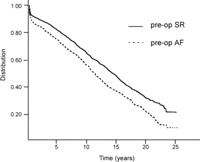
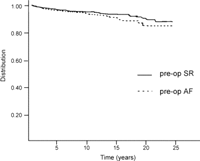
Freedom from embolic events. SR, sinus rhythm; AF, atrial fibrillation.
3.3 Cox regression
Risk factors for death and development of embolic complications are shown in Tables 2 and 3 (univariate analysis). Preoperative AF, postoperative AF, age, NYHA class, a procedure involving the mitral valve, female gender and associated coronary bypass grafting were mortality risk factors. Other types of surgery were not significant risk factors (not shown). There were 267 long-term embolic events in 264 patients (4.8%). Risk factors for the development of embolic complications included a procedure involving the mitral valve (P=0.0006) and both preoperative and postoperative AF showed statistical tendencies (P-values 0.0792 and 0.0657, respectively). Age, gender and NYHA class were not significant risk factors. Other types of surgery were not significant risk factors (not shown).
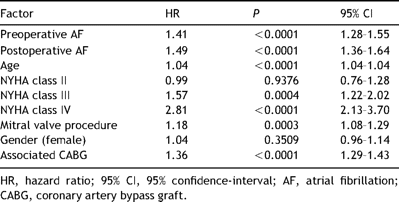

Multivariate analysis is shown in Tables 4 and 5 . Significant independent mortality risk factors included postoperative AF (HR=1.27), age (HR=1.05), sex (female, HR=1.26), and a procedure involving the mitral valve (HR=1.4). Preoperative AF was not a significant independent risk factor (HR=1.05, P=0.6). The only independent risk factor of embolic complications was a procedure involving the mitral valve (HR=1.55, P=0.0270).
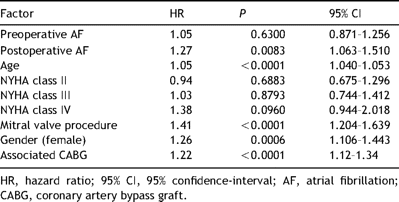
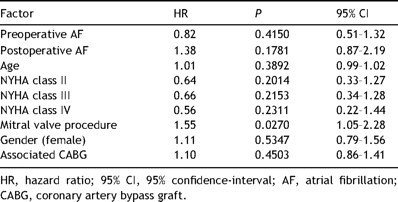
3.4 Interaction between preoperative and postoperative AF
When the variable of the interaction of preoperative and postoperative AF was added to the multivariate analysis shown above, this interaction was significant with a statistical tendency (HR=0.74, P=0.0748). In patients with preoperative sinus rhythm, the development of AF postoperatively was associated with increased mortality (HR=1.46, P=0.0012). In patients with preoperative AF, the persistence of AF postoperatively was not associated with increased mortality compared with definitive conversion to sinus rhythm (HR=1.07, P=0.5709).
3.5 Interaction between postoperative AF and mitral valve procedure
When the variable of the interaction of postoperative AF and a mitral procedure was added to the multivariate analysis shown above (Table 4), this interaction was not significant (HR=0.811, P=0.2122).
4 Discussion
Despite great success in conversion to sinus rhythm both as an isolated procedure [7,14] and in combination with valve procedures [2–8], the long-term clinical benefit of surgical AF ablation procedures has been difficult to demonstrate. Attempts at retrospective case-match studies have been made [15] but randomized controlled trials are lacking. This may be in part related to the variety of ablation line protocols and of different energy probes used across study groups. This may also be related to unclear surgical indications. Finally, this may be due to the fact that patients who remain in AF postoperatively but with ideal rate management and anticoagulation do relatively well, and that maintenance of sinus rhythm in some of these patients may be difficult [16,17]. This last hypothesis would be consistent with recent studies demonstrating impressive results in non-surgical patients with AF treated with rate management [12,13].
Our aim was to study the long-term impact of preoperative and postoperative rhythm in a large cohort of patients with valvular surgery. In patients with preoperative AF, we were specifically interested in determining whether postoperative spontaneous conversion to sinus rhythm was beneficial compared with persisting AF. These patients have not had a maze procedure. Of patients with preoperative AF, a significant amount (22.2%, n=304) converted spontaneously and definitively to sinus rhythm. All other rhythm persistence and cross-over patterns were observed and compared.
Unfavorable factors of long-term survival included age, a procedure involving the mitral valve, female gender, and the number of concomitant bypass grafts performed. Postoperative AF and NYHA class IV showed statistical tendency. Preoperative AF, although a significant risk factor on univariate analysis, was not an independent predictor of late mortality (HR=1.05, P=0.6300). The only independent risk factor of long-term embolic complications identified in this analysis was the need for a mitral valve procedure. Preoperative and postoperative AF were not significant risk factors. Twenty-year survival was still worse in patients with preoperative AF (23.7%) compared to patients with preoperative sinus rhythm (33.4%, P<0.0001).
When included in the analysis, a variable of interaction between preoperative AF and postoperative AF showed a positive statistical tendency (P=0.0748). This suggests that the impact of postoperative AF is not the same if patients were in sinus rhythm or if they were already in AF preoperatively. Postoperative AF was only a significant risk factor of long-term mortality in patients with preoperative sinus rhythm (HR=1.46, P=0.0012). Patients already in AF were not negatively affected by AF postoperatively. This may suggest that AF is a marker of advanced disease in these patients. Once AF develops, the patient may be joining a group with worse prognosis, and this may not be alterable by conversion to sinus rhythm, in the context of ideal follow-up, rate-control, and anticoagulation.
When included in the analysis, a variable of interaction between postoperative AF and a mitral valve procedure (mitral valve repair or replacement, with or without tricuspid repair) did not show statistical significance (HR=0.811, P=0.2122). This means that the impact of postoperative AF on mortality was not significant in this analysis, whether the patient had mitral surgery or not. This was also true when the analysis was conducted with patients who had isolated mitral valve repair.
This study is an observational study of the impact of rhythm status on clinical outcome after valve surgery. Patients with spontaneous conversion to sinus rhythm are not and should not be considered as equivalent to patient with a successful conversion by a maze procedure. Patients with spontaneous conversion are likely patients with less advanced disease, and perhaps had shorter AF span before surgery. The maze procedure has been shown to be applicable with successful conversion to sinus rhythm in patients with chronic, long-standing AF, and in patients with combined AF and advanced mitral disease. Those patients likely did not convert spontaneously in our analysis and those may be the patients that will benefit most from a surgical conversion to sinus rhythm.
Our results prompt for a randomized controlled trial of surgical AF-ablation procedures in the context of valvular disease. We demonstrated that the long-term clinical benefit of these procedures will inevitably be diluted by a significant amount of patients who would have naturally converted to sinus rhythm, probably patients with less advanced disease. Also, despite a large cohort, we were unable to demonstrate an impact of AF on the long-term incidence of embolic events. Therefore, the sample size of a randomized controlled trial designed to demonstrate the benefit of surgical AF-ablation procedures will need to be adjusted accordingly. This should probably be approached by a multi-center design.
Acknowledgements
Special thanks to Marie-Claude Guertin and Sylvie Levesque for help with data and statistics.
Appendix A
Conference discussion
Dr S. Redzepagic (Melbourne, Australia): I have just one point. Have you tried to identify the subgroups of patients who had mitral valve repair and mitral valve replacement?
Dr Chaput: Yes, we have.
Dr Redzepagic: Do you have any comments on that?
Dr Chaput: For mortality impact of atrial fibrillation, the results were similar in the mitral repair and the mitral replacement groups, and we present this analysis in a more detailed version of the paper. But for embolic complications we were unable to identify any factor in the mitral group alone because the numbers were smaller. We had around 2200 patients instead of more than 5000. So we had difficulty generating significant results for thromboembolism.
Dr J. Albes (Bernau-Berlin, Germany): You performed an excellent study. However, you defined the success just by the mortality of the sinus rhythm group versus the atrial fibrillation group. Did you also look at quality of life, on which sinus rhythm may have a positive impact in the postoperative course?
Dr Chaput: No, we did not.
Dr Albes: That's probably as important.
Dr Chaput: Yes. I think a large randomized trial should include an appreciation of the symptoms, because some patients will be symptomatic and those will benefit most from the procedure. However, it will require a larger setup to do that, and our database did not include that information.
Dr J. Melo (Carnaxide, Portugal): My comments are pretty in line with the first question. It is very important in studies like these to show which subsets of patients we can offer something by treating atrial fibrillation. The first evidence is that the risks regarding late survival and thromboembolic events for repairs and replacements are completely different. For repairs we know that thromboembolic event rates are extremely low and late survival is perfect. For prostheses, we have to consider biological and prosthetic and see the different subgroups. So with such a large database, it would be very important to have an in-depth analysis on that problem, because all the available literature until the moment points out that patients with mitral prostheses, either metallic or prosthetic, with atrial fibrillation have a three to four times higher probability of thromboembolic event rates.
Dr Chaput: We analyzed the mitral replacement and repair groups and we had similar survival results. We did not analyze the results compared between bioprostheses and mechanical prostheses. But, again, for the mitral group we were not able to demonstrate any risk factor even at a 7-year average follow-up for embolic complications.
Dr Melo: The real issue for me as a surgeon is the embolic event rates, and if you do follow-up like I've done, those patients with strokes are extremely impressive. So we need data from the different groups.
Dr Chaput: I know. Despite the fact that strokes are impressive, we had 267 events over a 24-year period. So it's very difficult to generate significant statistical results for embolic events despite long follow-up and a large group.
Dr T. Mesana (Ottawa, Ontario, Canada): I still have a methodological problem with your study. You said you had 5000 available patients, but are you sure you didn't exclude the patients that died that were probably not in your database?
Dr Chaput: People that died, that did not make it to 3-month follow-up, were not included in this analysis. This is a long-term analysis. It's not a short-term analysis.
Dr Mesana: Actually I presented a paper two days ago that exactly demonstrates the opposite of what you said. So that's why I was interested in your paper. Actually, when we enter our patients with a mitral valve replacement, for long-term follow-up in young patients there is a significant difference with mitral valve replacement, but when we enter the atrial fibrillation factor, this is the factor that makes the difference, not the fact that they have a mitral valve replacement. The long-term outcomes are poor if they have atrial fibrillation, not if they have mitral valve replacement, which is quite the opposite of what you said.
Dr Chaput: Yes then, for the impact of atrial fibrillation on long-term survival, we demonstrated the exact opposite with the follow-up we have.
References
Author notes
Presented at the joint 18th Annual Meeting of the European Association for Cardio-thoracic Surgery and the 12th Annual Meeting of the European Society of Thoracic Surgeons, Leipzig, Germany, September 12–15, 2004.




